New Growth Platforms for Automotive Brands
Introduction
I had prepared a short and concise presentation detailing the various strategies an automotive manufacturer should think about in order to create new growth platforms to explore growth beyond their core automotive products, for █████████. Constrained by time, it's far too brief for my liking, but it does help keep it fairly sharp and to the point–the perfect antidote for someone who tends to get lost in the weeds of any given subject matter.
Let's begin with the basics–what is the company, hereby named 'AutoX' good at? What are AutoX's current capabilities and strengths?
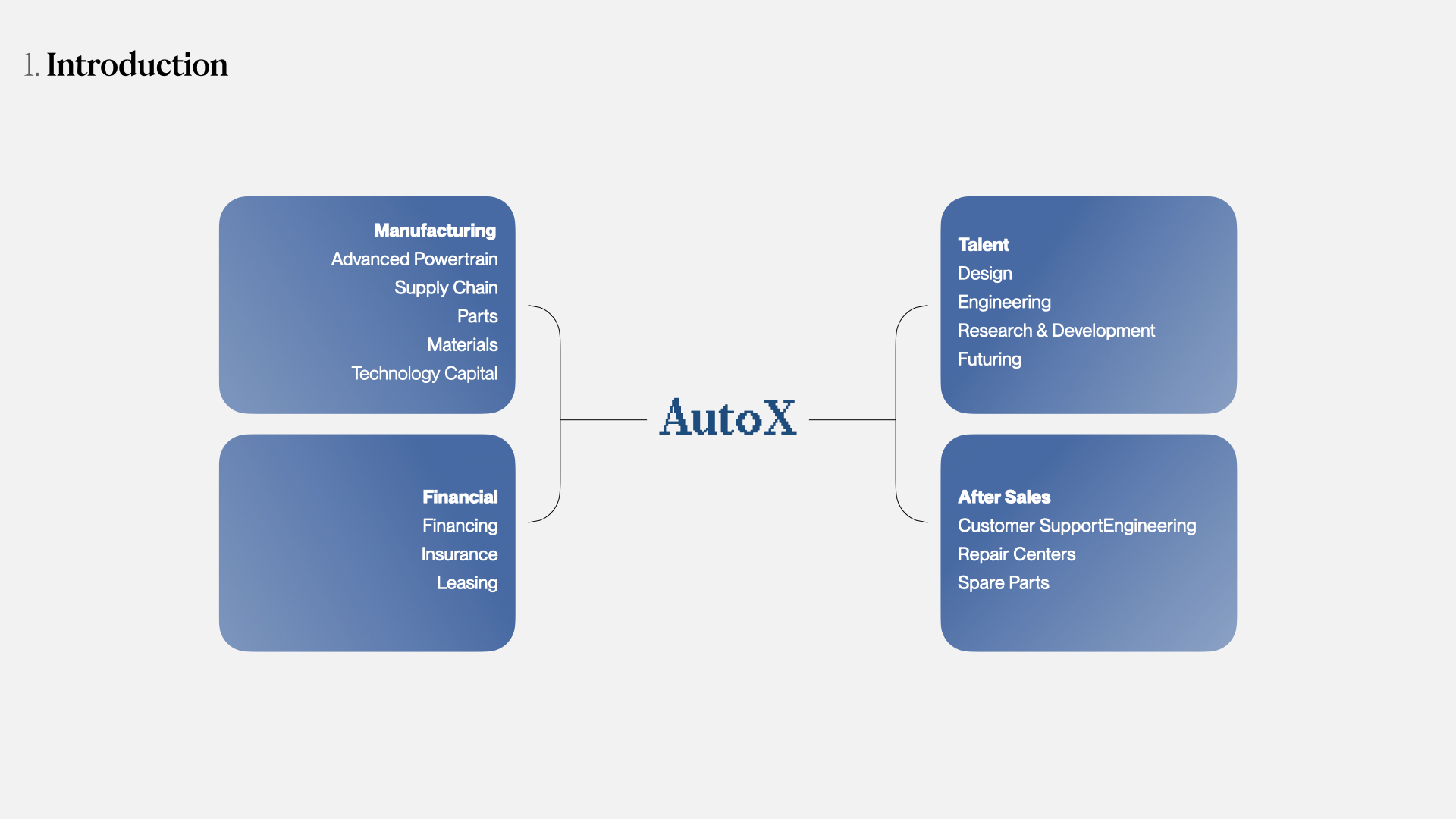
Automotive manufacturers don't just make money by selling cars. Financing, insurance and after sales support are strong revenue generators. The resources and talents needed to conceptualise, design, build, test, certify, market, advertise and profitably sell a vehicle is simply enormous. Many automotive companies differentiate themselves by developing in-house manufacturing processes and competencies (think advanced manufacturing techniques, patents, factories, and a highly talented workforce), something very few companies possess.
How can we leverage any of these diverse and often deep resources to build new growth platforms to create further growth for the business?
New Growth Platforms
Here's three potential concepts that one could choose from for new growth platforms.
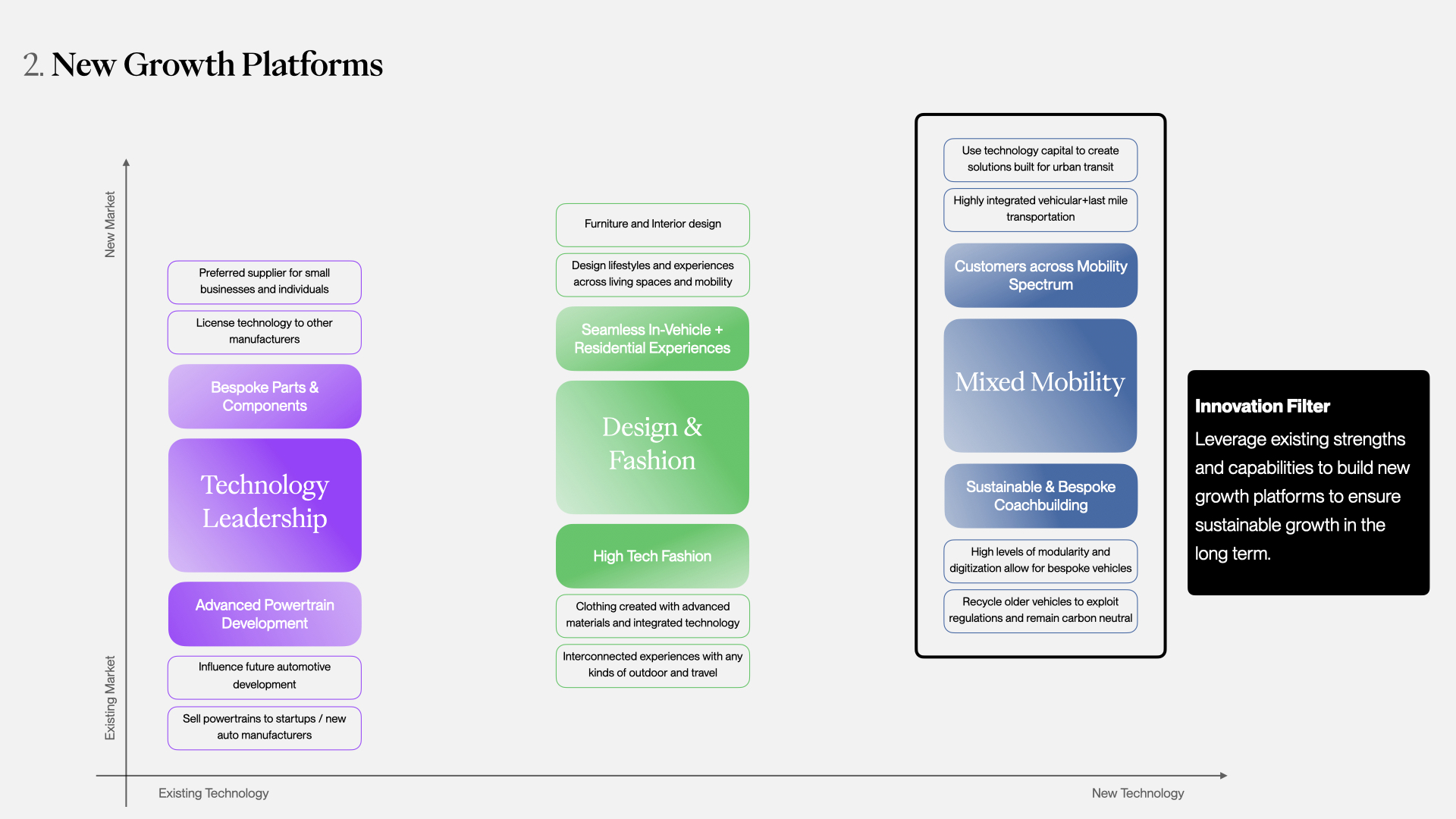
1. Technology Leadership
Low Risk | Short to Medium Term
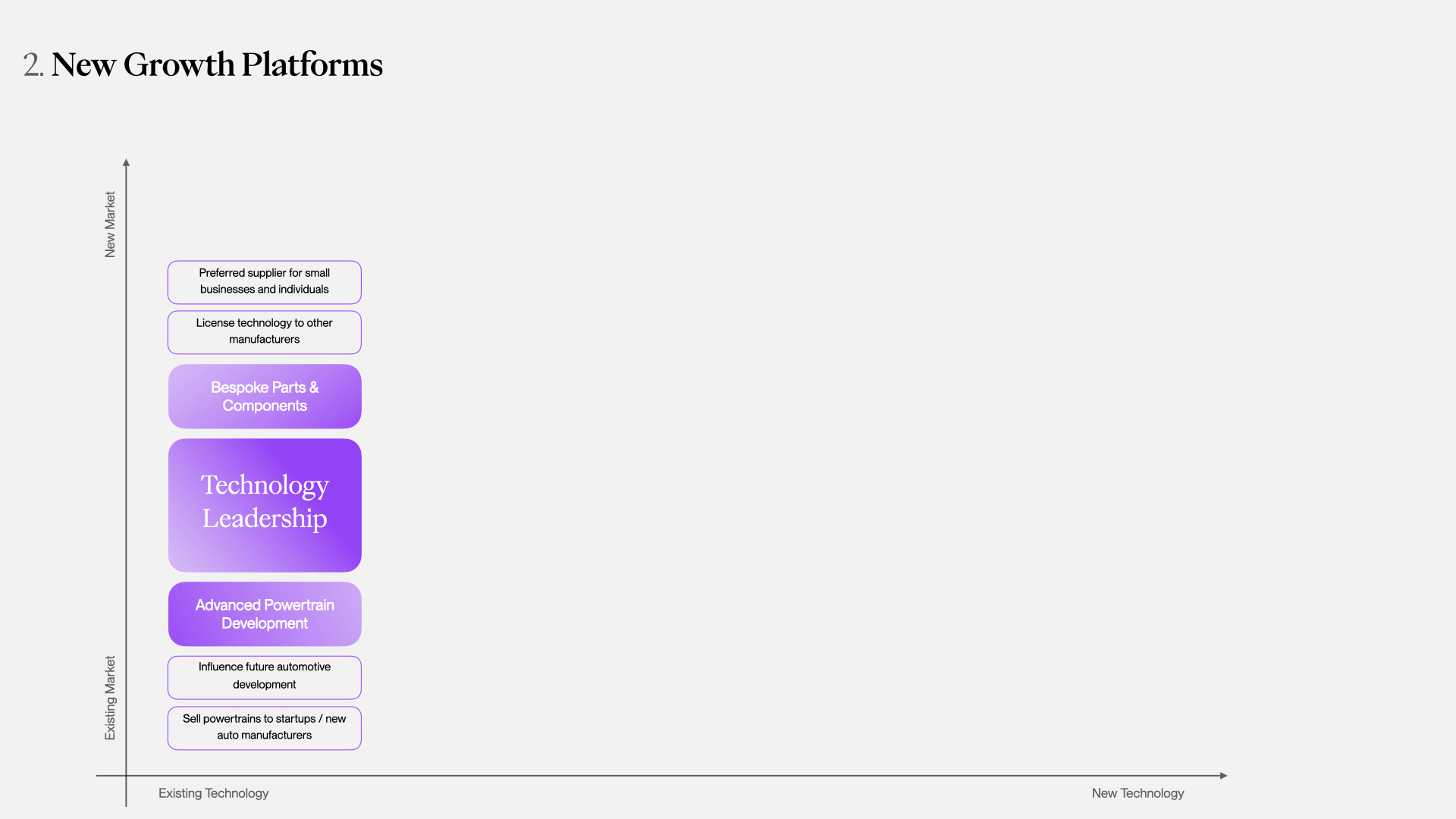
By leveraging existing technology, and tapping into an already established market, this is least risky strategy, but is best suited for short-term growth. There's two major components to this concept. The first of which is to use AutoX's advanced technology and manufacturing capability to create parts for other manufacturers and/or small business (independent repair shops, garages). Most cars on the road today, across price points use the same components or components created by the same supplier (tyres, brakes, suspensions, gearboxes and much more). ZF creates transmissions for low priced cars (Jeep Compass) and a Rolls Royce (RR Ghost). Often you might find a car using the same ZF transmission as another car twice or even thrice its price.
Why?
ZF is great at making transmissions. They excel at it, so much so that other manufacturers would rather use transmissions created by ZF instead of trying to create something better in-house. This is also a neat segue to the second component of this strategy: Advanced Powertrain Development. A car company is often great at designing powertrains, so why not focus on that and create powertrains for other manufacturers? This will not only enable AutoX to use its existing resources, but also give it the opportunity to be at the forefront of powertrain innovation, perhaps even influence or predict the direction the industry will move toward. Car manufacturing is becoming far more digitised (think modular, not screens and IoT), even more so with the advent of electric vehicles. This makes it easier (definitely not simple) and lowers the barrier of entry to manufacture cars at scale. By creating the best or preferred powertrains/components in the automotive industry, AutoX can use new branding models to eventually increase sales of its own vehicles.
Imagine if Intel used 'Intel Inside' to eventually drive sales to its own direct-to-consumer products, although we haven't seen much of this apart from the popular Intel NUC devices.
2. Design and Fashion
Medium Risk | Medium to Long Term
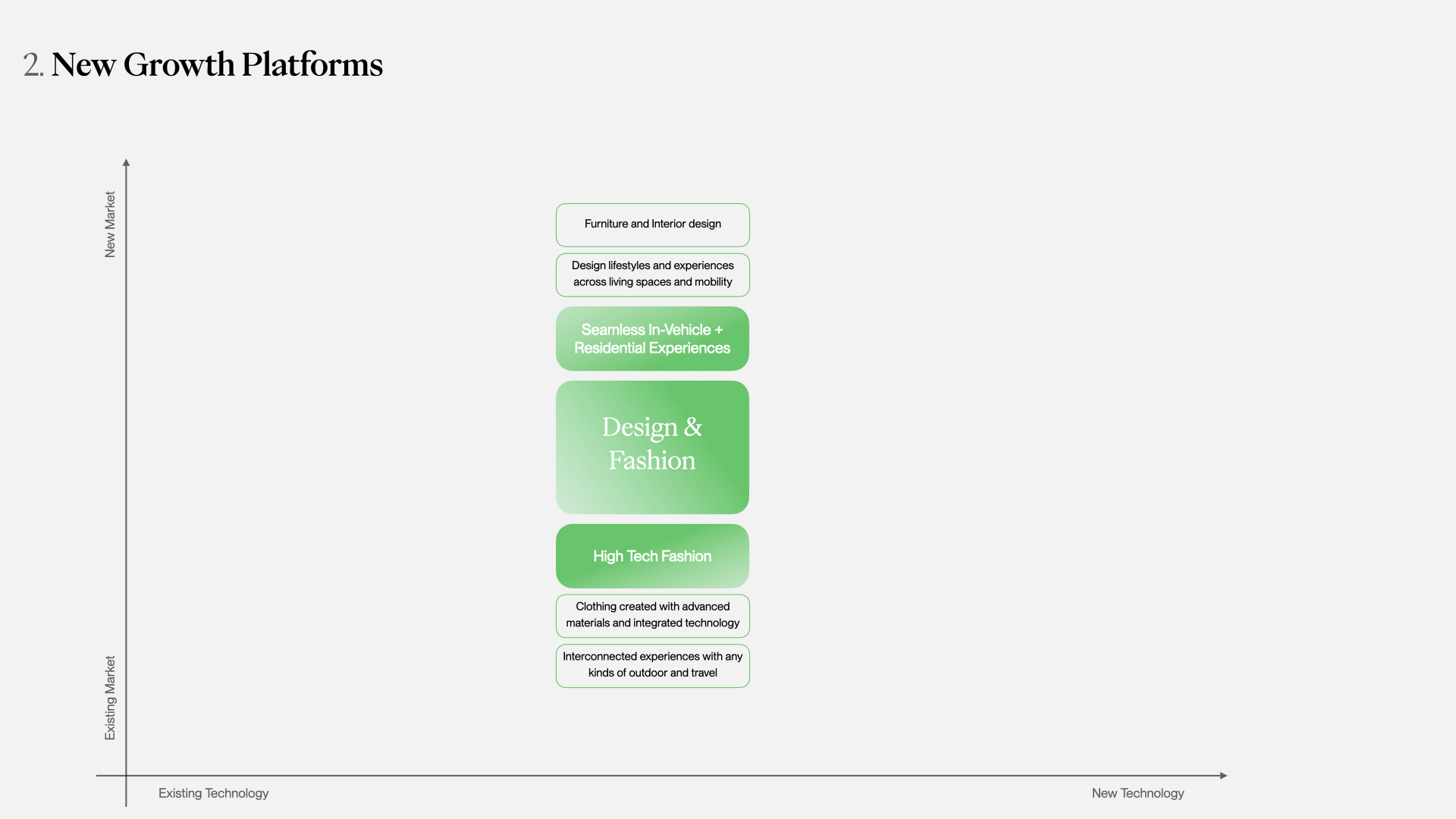
The one thing that separates a good automotive brand from a great one is their talent. Look at any Hyundai vehicle pre-2017 and post-2020. When a Hyundai created in the 2020's catches your eye like a Mercedes used to, you know the automotive landscape has changed. Design can make or break an automotive brand, and its one of the many reasons why talent is often poached, often repeatedly (the personnel who shuttle between the big German 3 is just exhausting, I've given up keeping track). This talent helps the brand look in the future (Futuring, speculative design), create cohesive experiences (Hardware, software to light and sound, to touch and feel), and make ownership satisfying (purchase and after sales).
How can AutoX use this wealth of talent to venture outside the car, and venture into new 'experiential' areas? People in certain parts of the world spend a lot of time in their vehicles (United States), and in other parts of the world, very little (Every other country with public transport). Can AutoX use its capabilities to design other parts of a person's life apart from mobility? Designers at AutoX go to great lengths to ensure people feel comfortable, and safe in the confined spaces of a vehicle—the same effort which would be immensely useful in designing living spaces in a residential or commercial setting. These experiences can be interlinked, connected and seamless, thus encouraging people to buy AutoX. The Apple 'ecosystem' experiment is a wildly successful one not because Apple enforces a lock-in, but by creating seamless experiences across devices, and across contexts. People want to be locked in the 'walled garden' because it is a wonderful place to be in (This is something any Android user will begrudgingly admit, including myself).
When I drive my car home, why can't my home adapt to my arrival by adjusting the climate control, light temperatures and other pre-selected adjustments? Apple CarPlay and Android Auto are aiming to do just that, by mediating in-car and living experiences. Car brands like AutoX can leverage their deep reserves of knowledge of materials, space, and more to create far richer experiences.
Why not push this understanding of materials even further—to fashion? It's not just the knowledge of materials which fashion and car brands have in common; both have immense capital of brand cache, which can often be seen through the various partnerships. Fiat-Gucci, McLaren-Period Correct, Peugeot-Lacoste, Volkswagen-Adidas, Lamborghini-Versace to name but a few. From Fiat-K Way and all the way to Bugatti-Hermès, there's something for everyone. Car brands are cool, and they've been historically important in both fashion and art (BMW Art Cars are a glaringly obvious example).
Venturing into fashion would be a fairly tried and tested market, which can only benefit from the knowledge of materials and integrated+embedded technology. Can AutoX design clothes for people who use utility vehicles which can allow them to more efficiently perform their tasks in conjunction with their vehicle and environment? What sort of fashion can help people accentuate their specific lifestyles with their vehicles?
3. Mixed Mobility
Low* Risk | Long Term
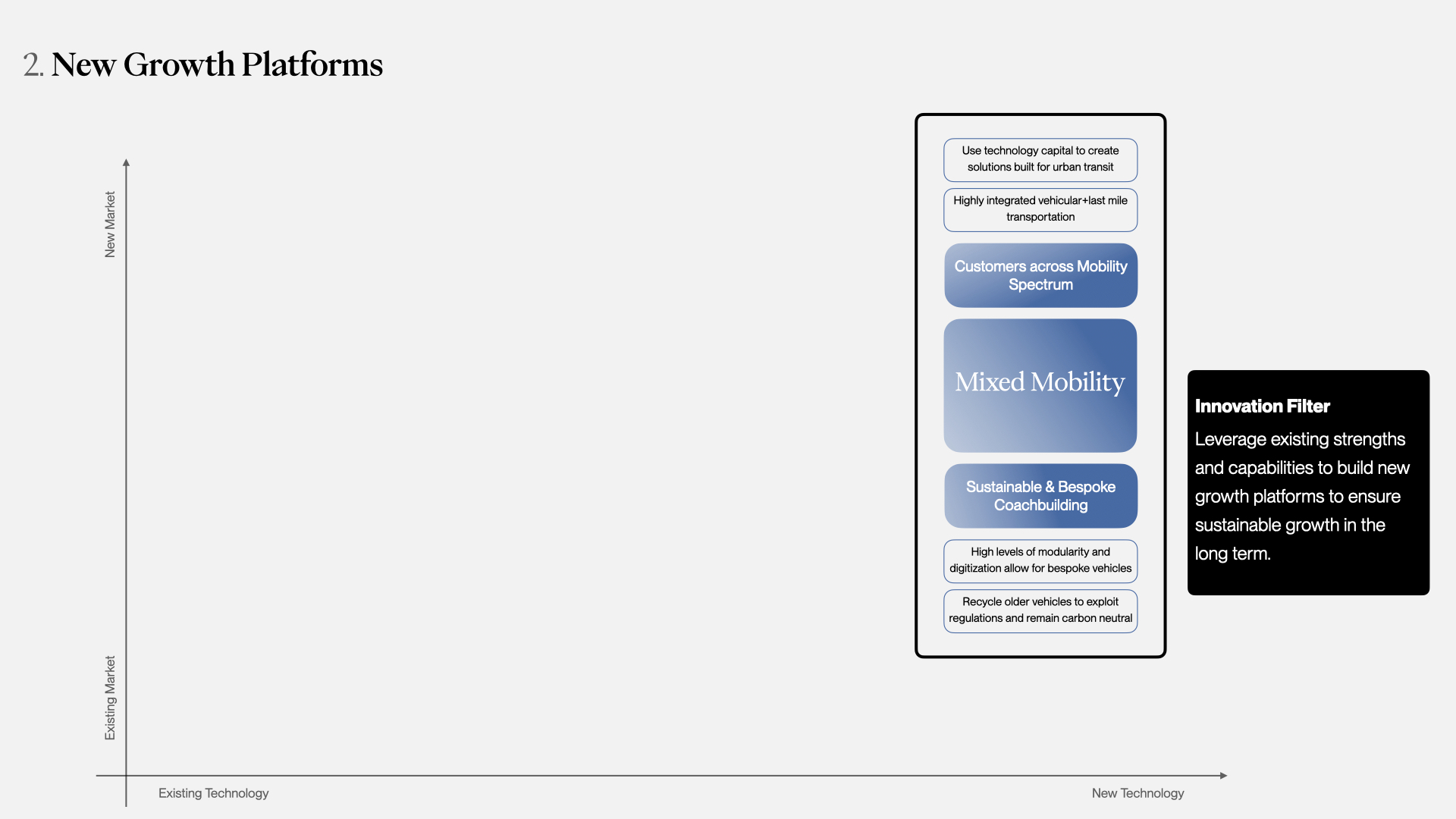
The Mixed Mobility concept calls for a strategy which rather paradoxically, looks for a way to sell less cars.
It's fairly obvious at this point that we're headed toward a future in which cars are not welcome in well developed urban cities. We're seeing cities become increasingly hostile to cars, and the inhabitants of the cities are more than happy to do away with cars and car ownership, especially once they've had a taste of car-free environments (COVID-19 induced lockdown cities). It's expensive to buy a car, and becoming ever more expensive (taxes, parking, energy) to use the car within cities. Barcelona has introduced 'superblocks' which are car-free spaces in the city centre in 2016, and other cities are slowly following suit.
Skyrocketing rents in city centres and increases in cost of living has reshaped how we live and work. People are starting to live in the outskirts or the suburbs, and commute to workplaces or travel for pleasure to areas within the city centre. This has led to an increase in mixed mode commuting—using multiple forms of transportation within a single journey. For example, a person may drive from their residence in the suburbs to a train station, board the train to the city centre, switch to a bus or an inner-city subway to get to the desired neighbourhood, and may switch to a last mile form of transportation in the form of a bicycle or scooter, or just simply walk. This single journey uses a car, train, bus, bicycle, and walking. Of course, this typology of mobility is not universal, and there will certainly be contexts where the car may well be the only viable, single mode of transportation available to them. But there is more than enough research to suggest that the car is a resource intensive and fairly inefficient form of transport as compared to public transit.
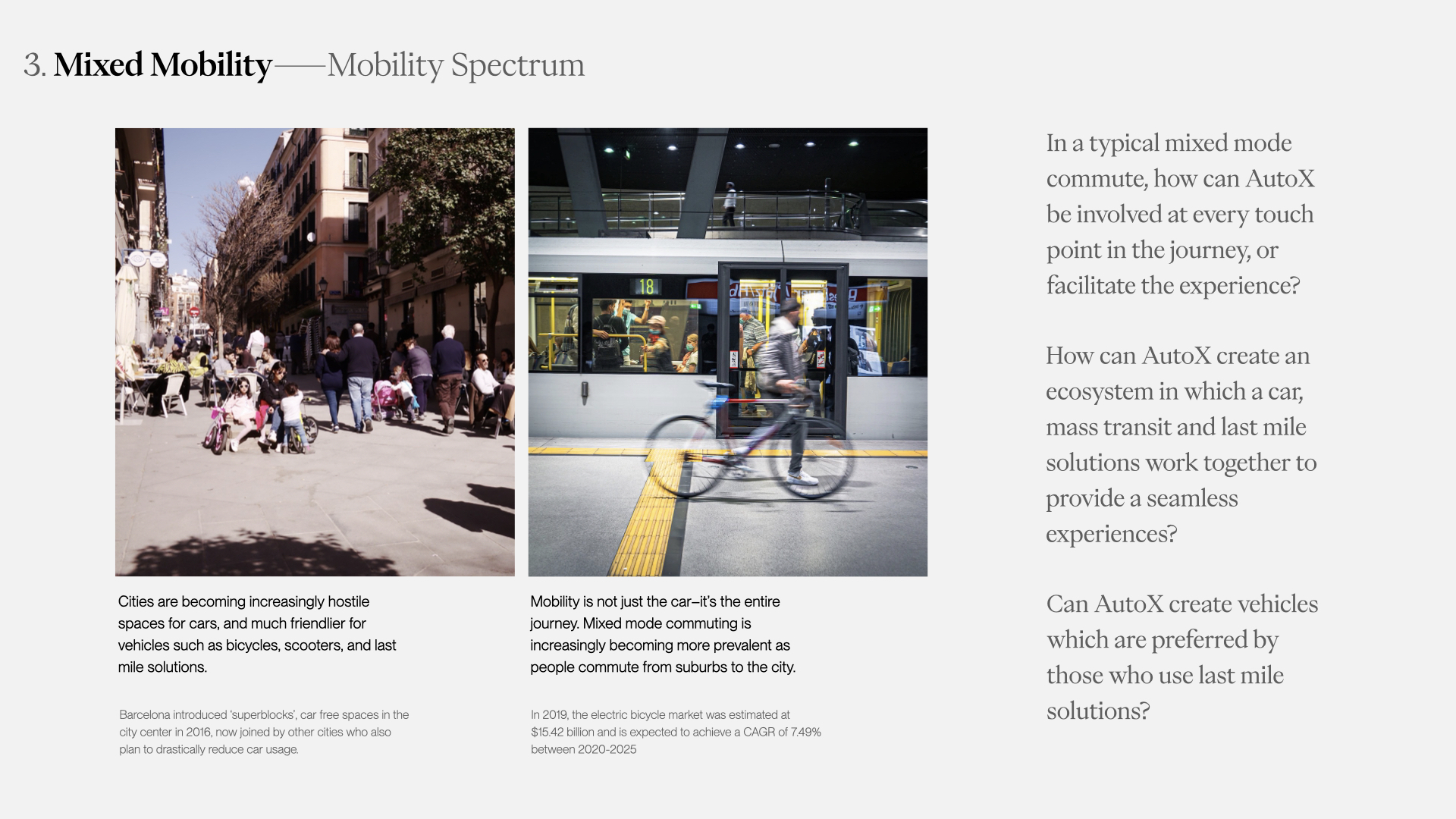
The switch to electric vehicles isn't going to solve this either. The resources required to create a vehicle are tremendous, and even more so for electric vehicles. Batteries and electrical components require a cocktail of elements, for which the mining and refining process is resource intensive and polluting. We are also starting to see regulators recognise this, and the carbon footprint of 'new' cars may well be taken into account when doing the maths on sustainability.
We're headed toward a future in which new cars are not welcome. How can AutoX adapt and continue to sustain or increase growth?
The first component of this strategy is to recognise and work toward a future in which mixed mobility is the norm. How can AutoX reach out to customers across the mobility spectrum (walking, to owning a car, and everything in between)? The Apple ecosystem is a great reference; by creating a seamless mobility experience across the spectrum, AutoX can transition a customer from an AutoX car to the multi modal mobility future facilitated by AutoX, and even gain new customers. This can take shape in various forms.
How can an AutoX vehicle fit into the mixed mobility journey far more effectively? Can the car communicate with city infrastructure and advise the driver on where to park and which form of transportation to switch in order to effectively complete their journey? Google Maps, through its easy to use interface has made transit systems incredibly easy to access and use. Google Maps is excellent at providing mixed mobility journey recommendations, which often include accurate times and location information which increases user confidence in the journey.
How can AutoX leverage its technology capital to create last mile transportation which work in conjunction with its vehicles? Can an AutoX e-bike be loaded onto an AutoX car with ease? Can the AutoX vehicle charge the AutoX e-bike as the car is driven to it's destination before the user switches to the e-bike to complete the journey? Can AutoX convince an e-bike/last mile transport solution user to invest in an AutoX car as it integrates better in their transportation journey? Porsche has recently invested in not one, but two e-bike companies. The e-bike market was estimated to be worth around $15.42 billion in 2019, and is expected to achieve a CAGR of 7.49% between 2020—2025. E-bikes are just one of many viable last mile transport solutions.
AutoX is not about cars. AutoX is about mobility. AutoX needs to find the most effective mobility solutions for their customers.
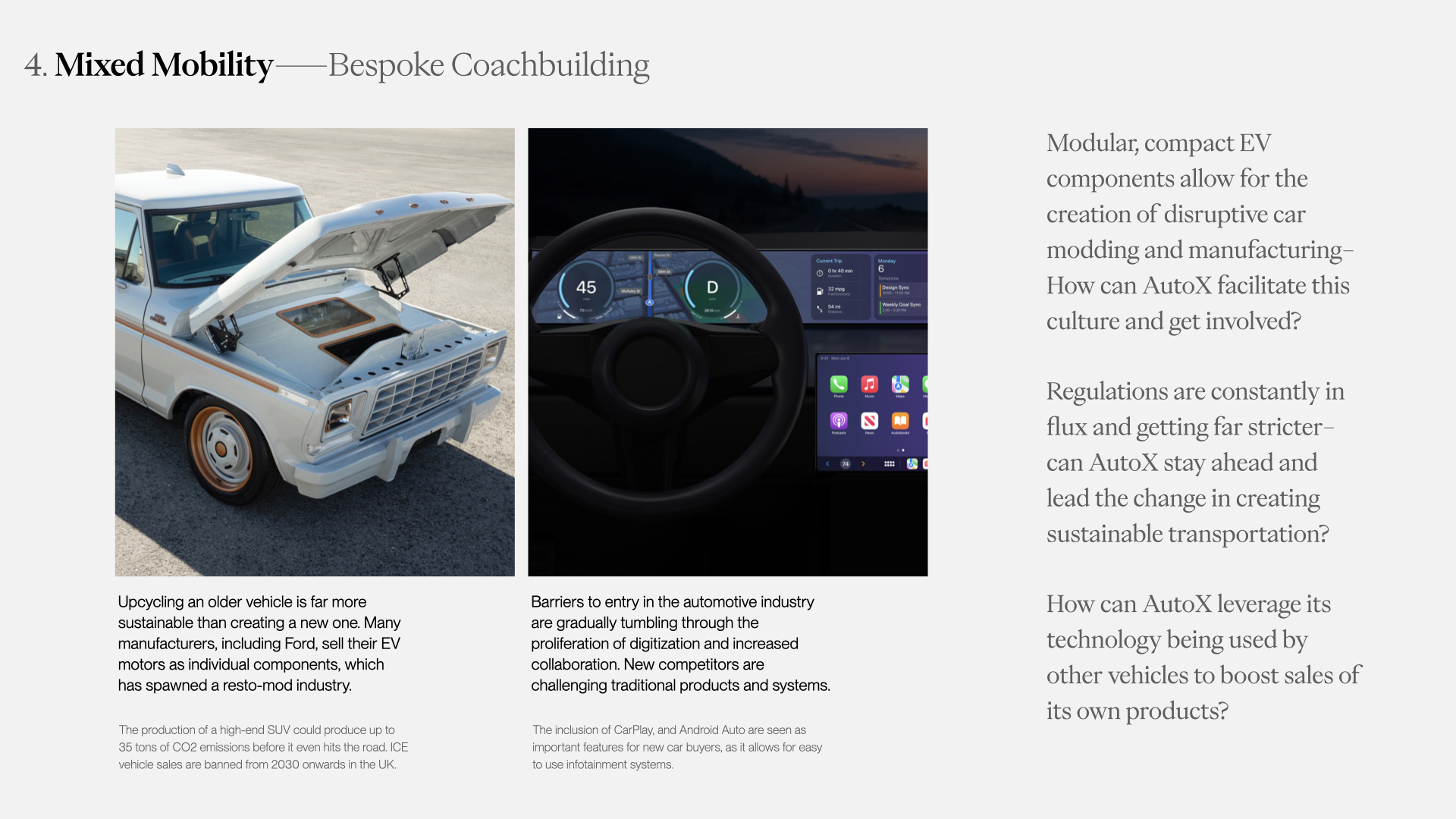
Cars will continue to remain relevant in this future. Remember, self driving cars in California (if they ever work, or prove their worth) doesn't mean self driving cars will ply the roads of Mumbai. Different futures can co-exist at the same time. Electric vehicles or vehicles powered by alternate means of energy (hydrogen/hydrogen fuel cell) will continue to be in demand, the question is—what will these cars look like?
As regulators become ever more scrupulous, car manufacturers will need to change their business models to adapt. Bespoke coachbuilding may well become a popular new meta. What is old, becomes new again. Coachbuilding was popular when cars first started catching on. Bentley, Rolls Royce and other luxury manufacturers were coachbuilders. They would create custom shells on rolling chassis for customers with discerning needs. We're already starting to see signs of this. Electric vehicle drivetrains are modular, and have a smaller footprint as compared to internal combustion engines and can easily be retro-fitted to any vehicle. Vintage cars are being retro-fitted and restored with off the shelf electric powertrains which not only increase performance, but also make them comply with city regulations, and in some cases even exempt them from taxation. Electric vehicles, or cars of a certain vintage are exempt from paying congestion tax in London.
Ford will sell you the same motor and inverter package they use on their flagship EV, the Mustang Mach-E, and many have done so to either retrofit their vehicles or create new cars altogether. Can AutoX use their technology capital to facilitate coachbuilding, and find new business models? Coachbuilding opens up the doors to highly customised, bespoke vehicle creation, which is a huge value add for certain segments. Why buy a standard executive saloon created by BMW, Mercedes or Audi, when you could get a customised resto-modded car for not much more?
References
Here's a few cultural signals I spotted during my research for this presentation.
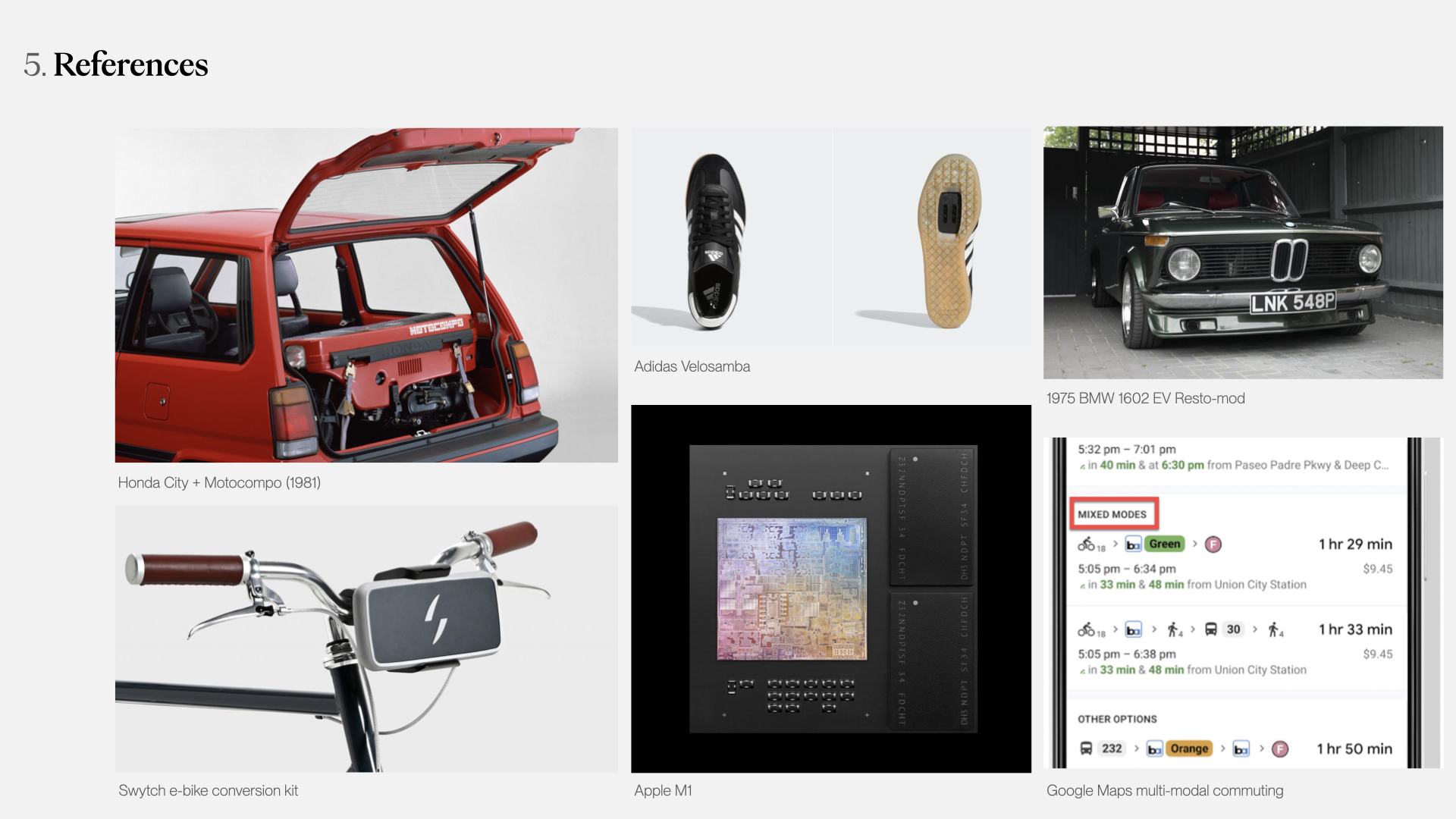
Honda City+Motocompo
Honda sold a small, foldable scooter with their small hatchback, the City in 1981. The idea being, you'd drive to the city in your City (nice), and then use the small scooter called the Motocompo to drive around in the city centre, before returning to the car.
Adidas Velosamba
Adidas has a sneaker with a small cutout in the sole which allows it to fit on a bicycle cleat.
1975 BMW 1602 EV Restomod
Featured on The Late Brake Show, someone restored an old BMW, and fitted it with an electric drivetrain for their daily commute in London. It costs the equivalent of a high end electric vehicle, and is exempt from road+congestion tax. Very tasteful, and far more interesting than a new car.
Swytch e-bike conversion kit
This kit contains a front wheel of a bike fitted with an electric hub motor, and pouch containing a battery which can be mounted on the handlebar. As the name suggests, it can convert any bike, old or new, into an e-bike.
Apple M1
Apple started designing their own chips in 2012, and shipped chips with incremental upgrades for years till everyone suddenly realised that iPads were faster than pro-level laptops. Apple shipped the MacBook Air with the M1 chip and overnight it changed what we come to expect from laptops. Industry leadership has its advantages.
Google Maps
Google Maps has enabled anyone to visit a new place and travel like a local, by allowing users to easily access and use mixed mode transport. This is a highly understated reason as to why people start using public transport and continue using it.